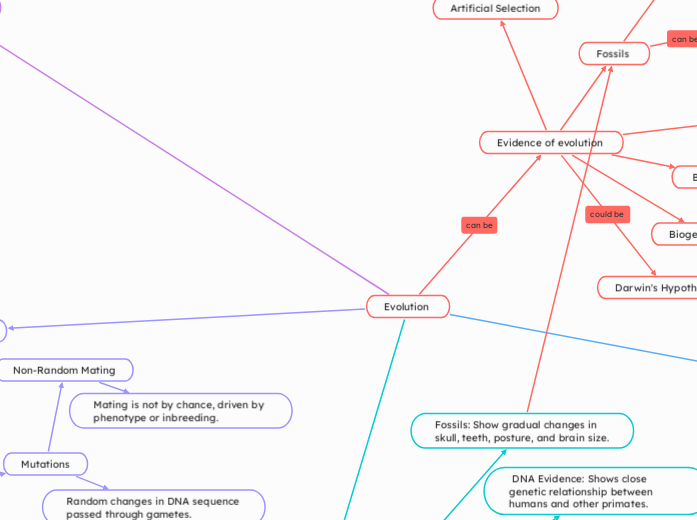Evolution
Evidence of evolution
Fossils
Fossils show a timeline of life, with changes and transitional forms linking ancient and modern species.
Comparative Anatomy
Homologous Structures Body parts with similar structures but different functions suggest a common ancestor.
Analogous Structures Similar functions but different structures show adaptation through convergent evolution.
Vestigial Structures
Useless or reduced organs are remnants of functional parts in ancestors.
Embryology
Early embryos of different vertebrates look alike, hinting at shared ancestry.
Biochemistry
(Molecular Biology) DNA and protein comparisons show how closely related organisms are on a genetic level.
Biogeography
Species distribution across the globe supports the idea of common origins and adaptation to environments.
Artificial Selection
Humans select traits in organisms (like crops or pets), showing how selection can shape species over time.
Darwin's Hypothesis
Species that reached remote islands by air or water evolved into new species due to isolation and adaptation.
Natural Selection
Process where organisms with traits that help them survive are more likely to live longer and have more offspring.
Darwin’s Finches: Different beak shapes adapted to different food sources; reduces competition.
Animal
Camouflage (e.g., insects, Potoo): Blending in increases survival.
Anteaters: Evolved longer tongues to access food in tunnels.
Cheetahs: Faster cheetahs catch prey more efficiently and reproduce more.
Adaptation: A trait that helps an organism survive or reproduce better in a certain environment.
Cobra: Defense mechanism.
Venus Fly Trap: Adaptation to low-nutrient environments.
Angler Fish: Bioluminescent lure helps catch prey in deep sea.
Walking Stick: Camouflage → predator avoidance.
Fossils in Africa: Predicted human origins based on living apes
Directional Selection:Favors one extreme version of a trait.
Stabilizing Selection: Favors the average trait, not the extremes.
Disruptive Selection: Favors both extreme traits, not the average.
Variation
Genetic Variation: Caused by differences in DNA (mutations, meiosis, sexual reproduction)
Environmental Variation:
Caused by surroundings (climate, diet, experiences)
Genetic Variation
Mutations: Random changes in DNA
Creates new gene combinations during reproduction
Sexual Reproduction: Mixing of genes from two parents
Microevolution
Genetic Drift
Gene Flow
Natural Selection: Individuals with favorable traits are more likely to survive and reproduce.
Stabilizing Selection
Directional Selection
Disruptive Selection
Sexual Selection
Movement of alleles between populations through migration.
Mutations
Non-Random Mating
Mating is not by chance, driven by phenotype or inbreeding.
Random changes in DNA sequence passed through gametes.
Random changes in allele frequencies in small populations.
Speciation
Microevolution – change in gene and allele frequency
(therefore phenotype traits) in a population
Speciation – evolutionary formation of a new species
Allopatric Speciation: Occurs when groups of the same species are separated by a physical barrier.
Sympatric Speciation: Occurs in the same geographic area.
Macroevolution – large evolutionary changes over
time that result in the formation of a new taxonomic
group
Reproductive Isolation: Prevents gene flow between species.
Prezygotic Mechanisms (before fertilization)
Ecological Isolation
Temporal Isolation
Behavioural Isolation
Mechanical Isolation
Gametic Isolation
Postzygotic Mechanisms (after fertilization)
Zygotic Mortality
Hybrid Inviability
Hybrid Infertility
Human Evolution
Primates: Humans belong to the order Primates.
Common Ancestor: Humans share a common ancestor with chimpanzees
Hominins: A group that includes modern humans and all of our extinct relatives that evolved after we split from a common ancestor with chimpanzees.
Australopithecus
Homo habilis
Homo erectus
Homo neanderthalensis
Homo sapiens (Modern Humans)
Fossils: Show gradual changes in skull, teeth, posture, and brain size.
DNA Evidence: Shows close genetic relationship between humans and other primates.
Artifacts & Tools: Tools show progression in intelligence and cultural development.
Carbon Dating: Helps determine age of fossils and tools.
Bipedalism
Larger Brain Size
Use of Tools
Language and Communication
Culture
